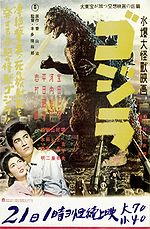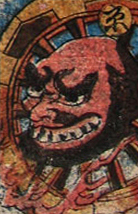Monster
This article needs additional citations for verification. (October 2016) |

A monster is a type of fictional creature found in
Animal monsters are outside the moral order, but sometimes have their origin in some human violation of the moral law (e.g. in the Greek
Monsters may also be depicted as misunderstood and friendly creatures who frighten individuals away without wanting to, or may be so large, strong and clumsy that they cause unintentional damage or death. Some monsters in fiction are depicted as mischievous and boisterous but not necessarily threatening (such as a sly goblin), while others may be docile but prone to becoming angry or hungry, thus needing to be tamed and taught to resist savage urges, or killed if they cannot be handled or controlled successfully.
Monsters pre-date written history, and the academic study of the particular cultural notions expressed in a society's ideas of monsters is known as monstrophy.[1] Monsters have appeared in literature and in feature-length films. Well-known monsters in fiction include Count Dracula, Frankenstein's monster, werewolves, vampires, demons, mummies, and zombies.
Etymology

Monster derives from the Latin monstrum, itself derived ultimately from the verb moneo ("to remind, warn, instruct, or foretell"), and denotes anything "strange or singular, contrary to the usual course of nature, by which the gods give notice of evil," "a strange, unnatural, hideous person, animal, or thing," or any "monstrous or unusual thing, circumstance, or adventure."[2]
Cultural heritage
In the words of Tina Marie Boyer, assistant professor of medieval German literature at Wake Forest University, "monsters do not emerge out of a cultural void; they have a literary and cultural heritage".[3]
In the religious context of ancient Greeks and Romans, monsters were seen as signs of "divine displeasure", and it was thought that birth defects were especially ominous, being "an unnatural event" or "a malfunctioning of nature".[4]
Monsters are not necessarily abominations however. The Roman historian Suetonius, for instance, describes a snake's absence of legs or a bird's ability to fly as monstrous, as both are "against nature".[5] Nonetheless, the negative connotations of the word quickly established themselves, and by the playwright and philosopher Seneca's time, the word had extended into its philosophical meaning, "a visual and horrific revelation of the truth".[6]
In spite of this, mythological monsters such as the
Monsters in fiction
Prose fiction
The history of monsters in fiction is long. For instance, Grendel in the epic poem Beowulf is an archetypal monster: deformed, brutal, and with enormous strength, he raids a human settlement nightly to slay and feed on his victims. The modern literary monster has its roots in examples such as the monster in Mary Shelley's Frankenstein and the vampire in Bram Stoker's Dracula.
Monsters are a staple of
Film
Pre–World War II monster films

During the age of
There was also a variant of Dr. Frankenstein, the mad surgeon Dr. Gogol (played by Peter Lorre), who transplanted hands that were reanimated with malevolent temperaments, in the film Mad Love.
Post–World War II monster films

In the post–World War II era, however, giant monsters returned to the screen with a vigor that has been causally linked to the development of nuclear weapons. One early example occurred in the American film The Beast from 20,000 Fathoms, which was about a dinosaur that attacked a lighthouse. Subsequently, there were Japanese film depictions, (Godzilla, Gamera), British depictions (Gorgo), and even Danish depictions (Reptilicus), of giant monsters attacking cities. A recent depiction of a giant monster is depicted in J. J. Abrams's Cloverfield, which was released in theaters 18 January 2008. The intriguing proximity of other planets brought the notion of extraterrestrial monsters to the big screen, some of which were huge in size (such as King Ghidorah and Gigan), while others were of a more human scale. During this period, the fish-man monster Gill-man was developed in the film series Creature from the Black Lagoon.

Britain's Hammer Film Productions brought color to the monster movies in the late 1950s. Around this time, the earlier Universal films were usually shown on American television by independent stations (rather than network stations) by using announcers with strange personas, who gained legions of young fans. Although they have since changed considerably, movie monsters did not entirely disappear from the big screen as they did in the late 1940s.
Occasionally, monsters are depicted as friendly or misunderstood creatures. King Kong and Frankenstein's monster are two examples of misunderstood creatures. Frankenstein's monster is frequently depicted in this manner, in films such as
Games
Monsters are commonly encountered in fantasy or role-playing games, as well as video games, as enemies for players to fight against. They may include aliens, legendary creatures, extra-dimensional entities or mutated versions of regular animals.
Especially in role-playing games, "monster" is a catch-all term for hostile characters that are fought by the player.
In some other games, such as
See also
Monsters in legend and fiction
This section's factual accuracy is disputed. (November 2023) |
- Abaia
- Almas
- Angel
- Bakunawa
- Banshee
- Basilisk
- Beast of Gévaudan
- Behemoth
- Bigfoot
- Bishop-fish
- Bogeyman
- Bunyip
- Centaur
- Cerberus
- Changeling
- Charybdis
- Chimera
- Cryptozoology
- Cyclopes
- Cetus
- Cockatrice
- Demon
- Draugr
- Dragon
- Dr. Jekyll and Mr. Hyde
- Dwarf
- Elf
- Extraterrestrial life
- Fairy
- Fearsome Critters
- Fouke Monster
- Frankenstein
- Gargoyle
- Gashadokuro
- Gill-man
- Goblin
- Ghoul
- Ghost
- Goblin
- Gorgon
- Gremlin
- Griffin
- Grim Reaper
- Gnome
- Headless Horseman
- Horned Serpent
- Imp
- Invisible Man
- Hydra
- Jiangshi
- Jinn
- Kaiju
- Kelpie
- Kraken
- Krampus
- Lake monster
- Loch Ness monster
- Legendary creature
- Leviathan
- Manticore
- Mermaid
- Midgard Serpent
- Minokawa
- Minotaur
- Mummy
- Mythological hybrid
- Ogre
- Oni
- Orc
- Pegasus
- Pixie
- Satyr
- Scylla
- Sea monster
- Skeleton
- Swamp monster
- Tarasque
- Troll
- Tikbalang
- Undead
- Vampire
- Warg
- Wendigo
- Werewolf
- Yaksha
- Yaoguai
- Yeti
- Yōkai
- Yara-ma-yha-who
- Zombie
Related concepts
References
Notes
- ^ Each card features a monster from Japanese mythology and a character from the hiragana syllabary.
Citations
- ^ "Call for Papers for Preternature 2.2". Dr Leo Ruickbie. 28 November 2011. Retrieved 30 December 2017.
- ^ The Rev. J.E. Riddle, A Complete English-Latin and Latin-English Dictionary, London: Longmans, Green, and Co., 1870, s.v. monstrum, Latin-English part, p. 399.
- ^ Boyer, Tina Marie (2013). "The Anatomy of a Monster: The Case of Slender Man". Preternature: Critical and Historical Studies on the Preternatural. 2 (2).
- ^ Beagon (2002), p. 127.
- ^ Wardle (2006), p. 330.
- ^ Staley (2010), pp. 80, 96, 109, 113 et passim.
Bibliography
- Asma, Stephen (2009). On Monsters: An Unnatural History of Our Worst Fears. Oxford University Press. ISBN 978-0195336160.
- Beagon, Mary (2002). "Beyond Comparison: M. Sergius, Fortunae victor". In Clark, Gillian; Rajak, Tessa (eds.). Philosophy and Power in the Graeco-Roman World: Essays in Honour of Miriam Griffin. Oxford University Press. ISBN 978-0-19-829990-5.
- Staley, Gregory A. (2010). Seneca and the Idea of Tragedy. Oxford University Press. ISBN 978-0-19-538743-8.
- Wardle, David (2006). Cicero on Divination, Book 1. Oxford University Press.
- Weinstock, Jeffrey Andrew, ed. (2020). The Monster Theory Reader. University of Minnesota Press. 2020.
External links
 Media related to Monsters at Wikimedia Commons
Media related to Monsters at Wikimedia Commons
